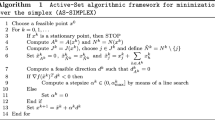Abstract
This paper presents a degenerate extreme point strategy for active set algorithms which classify linear constraints as either redundant or necessary. The strategy makes use of an efficient method for classifying constraints active at degenerate extreme points. Numerical results indicate that significant savings in the computational effort required to classify the constraints can be achieved.
Similar content being viewed by others
References
Karwan, M. H., Lotfi, V., Telgen, J., andZionts, S., Editors,Redundancy in Mathematical Programming: A State of the Art Survey, Springer-Verlag, Berlin, Germany, 1983.
Boot, J. C. G.,On Trivial and Binding Constraints in Programming Problems, Management Science, Vol. 8, pp. 419–441, 1962.
Zionts, S.,Size Reduction Techniques of Linear Programming and Their Applications, Carnegie Institute of Technology, PhD Thesis, 1965.
Thompson, G. L., Tonge, F. M., andZionts, S.,Techniques for Removing Nonbinding Constraints and Extraneous Variables from Linear Programming Problems, Management Science, Vol. 12, pp. 588–608, 1966.
Gal, T.,A Method for Determining Redundant Constraints, Redundancy in Mathematical Programming: A State of the Art Survey, Edited by M. H. Karwan, V. Lotfi, J. Telgen, and S. Zionts, Springer-Verlag, Berlin, Germany, pp. 36–52, 1983.
Telgen, J.,Identifying Redundancy in Systems of Linear Constraints, Redundancy in Mathematical Programming: A State of the Art Survey, Edited by M. H. Karwan, V. Lotfi, J. Telgen, and S. Zionts, Springer-Verlag, Berlin, Germany, pp. 53–59, 1983.
Rubin, D. S.,Finding Redundant Constraints in Sets of Linear Inequalities, Redundancy in Mathematical Programming: A State of the Art Survey, Edited by M. H. Karwan, V. Lotfi, J. Telgen, and S. Zionts, Springer-Verlag, Berlin, Germany, pp. 60–67, 1983.
Zionts, S., andWallenius, J.,A Method for Identifying Redundant Constraints and Extraneous Variables in Linear Programming, Redundancy in Mathematical Programming: A State of the Art Survey, Edited by M. H. Karwan, V. Lotfi, J. Telgen, and S. Zionts, Springer-Verlag, Berlin, Germany, pp. 28–35, 1983.
Dantzig, G. B.,Linear Programming and Extensions, Princeton University Press, Princeton, New Jersey, 1963.
Best, M. J., andRitter, K.,Linear Programminng: Active Set Analysis and Computer Programs, Prentice-Hall, Englewood Cliffs, New Jersey, 1985.
Caron, R. J., McDonald, J. F., andPonic, C. M.,Classification of Linear Constraints as Redundant or Necessary, University of Windsor, Windsor Mathematics Report No. WMR-85-09, 1985.
Boneh, A.,Preduce: A Probabilistic Algorithm for Identifying Redundancy by a Random Feasible Point Generator, Redundancy in Mathematical Programming: A State of the Art Survey, Edited by M. H. Karwan, V. Lotfi, J. Telgen, and S. Zionts, Springer-Verlag, Berlin, Germany, pp. 108–134, 1983.
Mangasarian, O. L.,Nonlinear Programming, McGraw-Hill, New York, New York, 1969.
Bland, R. G.,New Finite Pivoting Rules for the Simplex Method, Mathematics of Operations Research, Vol. 2, pp. 103–107, 1977.
Caron, R. J., McDonald, J. F., andPonic, C. M., Clasfy:A Fortran IV Subroutine to Classify Linear Constraints—Users' Guide, University of Windsor, Windsor Mathematics Report No. WMR-85-08, 1985.
Kotiah, T. C. T., andSteinberg, D. I.,Occurrences of Cycling and Other Phenomena in a Class of Linear Problems, Communications of the Association of Computing Machinery, Vol. 20, pp. 107–112, 1977.
Grierson, D. E., andAly, A. A.,Plastic Design under Combined Stresses, Journal of the Engineering Mechanics Division, ASCE, Vol. 106, pp. 585–607, 1980.
Keerthi, S. S., andGilbert, E. G.,Computation of Minimum Time Feedback Control Laws for Discrete-Time Systems with State-Control Constraints, Paper Presented at the Conference on Information Sciences and Systems, Princeton University, Princeton, New Jersey, 1986.
Author information
Authors and Affiliations
Additional information
Communicated by D. F. Shanno
This research was supported by the Natural Sciences and Engineering Research Council of Canada under Grants A8807 and A4625 and by an Undergraduate Summer Research Award.
Rights and permissions
About this article
Cite this article
Caron, R.J., McDonald, J.F. & Ponic, C.M. A degenerate extreme point strategy for the classification of linear constraints as redundant or necessary. J Optim Theory Appl 62, 225–237 (1989). https://doi.org/10.1007/BF00941055
Issue Date:
DOI: https://doi.org/10.1007/BF00941055




